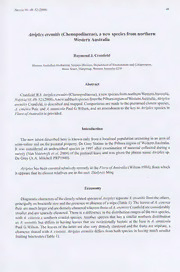Table Of Content49
Nuytsia 18 : 49-52 (2008)
Atriplex eremitis (Chenopodiaceae), a new species from northern
Western Australia
Raymond J. Cranfield
Western Australian Herbarium, Science Division, Department of Environment and Conservation,
Brain Street, Manjimup, Western Australia 6258
Abstract
Cranfield, R.J. Atriplex eremitis (Chenopodiaceae), a new species from northern Western Australia.
Nuytsia 18: 49-52 (2008). Anew saltbush species from the Pilbara region of Western Australia, Atriplex
eremitis Cranfield, is described and mapped. Comparisons are made to the presumed closest species,
A. cinerea Poir. and A. amnicola Paul G.Wilson, and an amendment to the key to Atriplex species in
Flora of Australia is provided.
Introduction
The new taxon described here is known only from a localised population occurring in an area of
semi-saline soil on the pastoral property, De Grey Station in the Pilbara region of Western Australia.
It was considered an undescribed species in 1997 after examination of material collected during a
survey (Van Vreeswyk et al. 2004) of the pastoral lease and was given the phrase name Arriplex sp.
De Grey (A.A. Mitchell PRP 1940).
Atriplex has been covered relatively recently in the Flora of Australia (Wilson 1984), from which
it appears that its closest relatives are in the sect. Dialysex Mogq.
Taxonomy
Diagnostic characters of the closely related species of Atriplex separate A. eremitis from the others,
principally on bracteole size and the presence or absence of a stipe (Table 1). The leaves ofA . cinerea
Poir. are much larger and are densely clustered whereas those of A. eremitis Cranfield are considerably
smaller and are sparsely clustered. There is a difference in the distribution ranges of the two species,
with A. cinerea a southern coastal species. Another species that has a similar northern distribution
as A. eremitis but differs in having leaves that are occasionally hastate at the base is A. amnicola
Paul G.Wilson. The leaves oft he latter are also very densely clustered and the fruits are stipitate, a
character shared with A. cinerea. Atriplex eremitis differs from both species in having much smaller
fruiting bracteoles (Table 1).
50 Nuytsia Vol. 18 (2008)
Table 1. Characters distinguishing A. eremitis from related Atriplex species.
Character A. eremitis A, cinerea A, amnicola
Leaf
Outline entire entire entire-hastate
Length (mm) 4-16 25-40 10-25
Lamina shape elliptic-oblong elliptic-ovate elliptic-oblong
Lamina base attenuate rounded cuneate-hastate
Fruiting bracteole
Attachment sessile stipitate-subsessile sessile
Length (mm) 1.5-2 6-10 6-10
Width (mm) 1.5-2 6-10 4-6
Atriplex eremitis Cranfield, sp. nov.
Atriplex cinereae Poir. affinis sed statura parviore, bracteolis sessilibus 1.542 mm longis, et foliis
sparsis differt.
Typus: De Grey Station [precise locality withheld for conservation reasons], 28 August 1997,
A.A. Mitchell PRP1940 (holo: PERTH 04867610).
Erect, open sub-shrub to 30 cm high, monoecious or dioecious. Branches slender, smooth, with
pale, buff- coloured bark. Leaves widely spaced along branches; lamina thin, narrowly elliptic to
oblong, obtuse, attenuate at base, 4-16 x 2-6 mm, vesiculate with a grey scurfy appearance on both
surfaces. Male flowers in glomerules c. 2 mm diameter, forming a short panicle. Female flowers in
axillary clusters without associated male glomerules or occasionally the basal portion of an interrupted
spike subtending male glomerules. Fruiting bracteoles 1/3 united, sessile, scurfy, rhomboid to deltoid,
1.542 x 1.54-2 mm, with 3 obtuse lobes. Seed circular, c. 1 mm diameter; testa faintly reticulate, cream
to brown; radicle lateral, erect.
Distribution. Known only from the type locality on De Grey Station, Western Australia (Figure 1).
This locality is a coastal portion of the Eremaean Botanical Province (Beard 1980) and is within the
Pilbara Bioregion (Thackway & Cresswell 1995).
Habitat. Tussock grassland associated with Eragrostis xerophila Domin and the introduced Cenchrus
ciliaris L. occurring as a component of a sub-unit of the Anna land system composed of level sand
plains and a mosaic of saline plains (Van Vreeswyk 2004).
Flowering time. The only collection oft his species was flowering in August.
Conservation status. Recently listed as Priority One under Department of Environmentand Conservation
(DEC) Conservation Codes for Western Australian Flora. Additional surveys are required to determine
whether this species warrants endangered status.
R.J. Cranfield, Atriplex eremitis (Chenopodiaceae), a new species 51
WESTERN 1A USTRALIA
THE PILBARA
Figure 1. Distribution of Atriplex eremitis (M1) in
Western Australia.
Etymology. From the Greek eremia (desert, solitude) referring to the desert location and recluse nature
of this species.
Notes. Although considered to be essentially dioecious, there is a degree of uncertainty as to whether
this species is instead monoecious. Both male and female flowers were found on the material examined
but the presence of male flowers was more obvious. It has been noted on several other monoecious
species that occasional female flowers can occur on predominantly male plants and that this collection
may not have sampled a female plant. Additional collections of this species can be expected to resolve
this issue.
Amendments to the key to Atriplex species in Flora of Australia
For Atriplex eremitis the key for sect.V Dialysex (p. 90) should be altered to read from couplet
12:
12: Plant dioecious; leaves scurfy or scaly on both surfaces
12a Leaves 25-40 mm long, bracteole 6-10mm long
12a:Leaves 4-16 mm long, bracteoles 1.54-2 mm long
Acknowledgements
I wish to thank P.G. Wilson for his Latin diagnosis and advice and T. Macfarlane for comments
and guidance.
52 Nuytsia Vol. 18 (2008)
References
Beard, J.S. (1980). A new phytogeographic map of Western Australia. Western Australian Herbarium Research Notes 3:
37-58.
Thackway, R. & Cresswell, I.D. (1995). An Interim Biogeographic Regionalisation for Australia (IBRA), Version 4. (Australian
Nature Conservation Agency: Canberra.)
Van Vreeswyk, A.M.L., Payne, A.L., Leighton, K.A. & Hennig, P. (2004). An inventory and condition survey of the Pilbara
region, Western Australia. Technical Bulletin 92 (Department of Agriculture: South Perth.)
Wilson, P.G. (1984). Chenopodiaceae. Jn: George, A.S. (ed) Flora of Australia.Vol. 4, pp. 84-132. (Australian Government
Publishing Service: Canberra.)

